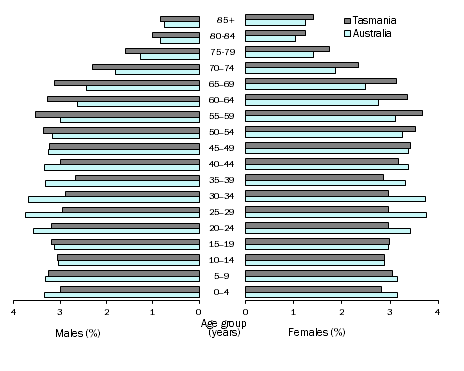|
|
TASMANIA
MEDIAN AGE
- At June 2016, the median age (the age at which half the population is older and half is younger) of the Tasmanian population was 42.0 years, the highest of all states and territories. Tasmania also had the largest increase in median age between 2006 and 2016, increasing by 3.1 years. The median age of males in 2016 was 41.0 years compared with 43.0 years for females.
- The areas with the highest median ages in 2016 were Triabunna - Bicheno (55.5 years), Forestier - Tasman (55.1) and St Helens - Scamander (53.8), all located on Tasmania's eastern seaboard. The lowest median age was in Bridgewater - Gagebrook (31.0 years) in Greater Hobart, followed by Mowbray (31.1) in Launceston, which is close to the University of Tasmania and other educational facilities.
SA2s WITH OLDEST AND YOUNGEST MEDIAN AGES(a), Tasmania, 2016 |
|
 |  | Median Age |
| SA2 | GCCSA | years |
OLDEST MEDIAN AGES |
|
| Triabunna - Bicheno | Rest of Tas | 55.5 |
| Forestier - Tasman | Rest of Tas | 55.1 |
| St Helens - Scamander | Rest of Tas | 53.8 |
| Bruny Island - Kettering | Rest of Tas. | 53.5 |
| Beauty Point - Beaconsfield | Rest of Tas | 53.0 |
YOUNGEST MEDIAN AGES |
|
| Bridgewater - Gagebrook | Greater Hobart | 31.0 |
| Mowbray | Rest of Tas | 31.1 |
| Rokeby | Greater Hobart | 31.3 |
| Newnham - Mayfield | Rest of Tas | 33.1 |
| Risdon Vale | Greater Hobart | 34.2 |
|
| (a) Excludes SA2s with a population of less than 1,000 at June 2016. |
- Beauty Point - Beaconsfield had the largest increase in median age between June 2006 and June 2016 (up 9.8 years). The SA2s of Newstead, an inner suburb of Launceston, and West Moonah in Greater Hobart recorded the largest decreases in median age over this period (both down by 1.3 years).
SEX RATIO
- At June 2016, the sex ratio of Tasmania was 97.7 males per 100 females, up from 97.2 in 2006.
- Risdon Vale, in Hobart's north-eastern suburbs, was the SA2 with the highest sex ratio (131.6 males per 100 females) due in part to the male population of Risdon Prison. The next highest sex ratios were in Central Highlands (115.3) and Derwent Valley (112.5).
- The lowest sex ratios were in Newstead (85.7 males per 100 females), an inner suburb of Launceston, and Devonport (86.3) on Tasmania's north coast.
SA2s WITH HIGHEST AND LOWEST SEX RATIOS(a), Tasmania, 2016 |
|
 |  | Sex Ratio |
| SA2 | GCCSA | males per 100 females |
HIGHEST SEX RATIOS |
|
| Risdon Vale | Greater Hobart | 131.6 |
| Central Highlands | Rest of Tas | 115.3 |
| Derwent Valley | Rest of Tas | 112.5 |
| Waratah | Rest of Tas | 112.4 |
| Bruny Island - Kettering | Rest of Tas | 109.8 |
LOWEST SEX RATIOS |
|
| Newstead | Rest of Tas | 85.7 |
| Devonport | Rest of Tas | 86.3 |
| South Launceston | Rest of Tas | 87.1 |
| Miandetta - Don | Rest of Tas | 88.5 |
| Norwood | Rest of Tas | 88.8 |
|
| (a) Excludes SA2s with a population of less than 1,000 at June 2016. |
AGE AND SEX DISTRIBUTION
- The age distribution of Tasmania's population at June 2016 was characterised by a lower proportion of people aged 20 to 44 years (30%) than the Australian population (35%). This in part reflects a net outflow of young adults from Tasmania to pursue education and employment opportunities interstate. Tasmania also had a higher proportion of people aged 45 years and over (46%) than Australia as a whole (40%). This partly reflects a trend of adults in this age group moving into the state.
AGE AND SEX DISTRIBUTION (%), Tasmania and Australia - 30 June 2016

|
|
 Quality Declaration
Quality Declaration  Print Page
Print Page
 Print All
Print All